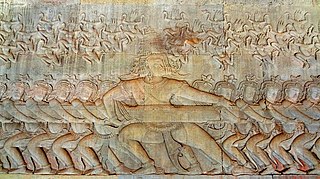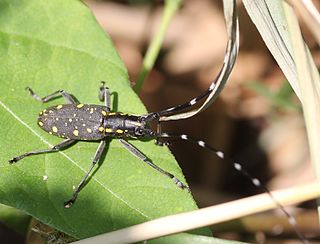
Asuras are a class of beings in Indian religions. They are described as power-seeking beings related to the more benevolent Devas in Hinduism. In its Buddhist context, the word is translated as "titan" or "antigod".

The daityas are a race of asuras in Hindu mythology, descended from Kashyapa and his wife, Diti. Prominent members of this race include Hiranyaksha, Hiranyakashipu, and Mahabali, all of whom overran the earth, and required three of Vishnu's avataras to be vanquished.

Deva means 'shiny', 'exalted', 'heavenly being', 'divine being', 'anything of excellence', and is also one of the Sanskrit terms used to indicate a deity in Hinduism. Deva is a masculine term; the feminine equivalent is Devi. The word is a cognate with Latin deus ('god') and Greek Zeus.

The Samudra Manthana is a major episode in Hinduism that is elaborated in the Vishnu Purana, a major text of Hinduism. The Samudra Manthana explains the origin of the elixir of eternal life, amrita.

An asura in Buddhism is a demigod or titan of the Kāmadhātu. They are described as having three heads with three faces each and either four or six arms.

In Hindu cosmology, the Kshira Sagara or Ocean of Milk is the fifth from the centre of the seven oceans. It surrounds the continent known as Krauncha. According to Hindu scriptures, the devas and asuras worked together for a millennium to churn this ocean in order to acquire amrita, the elixir of immortal life. The episode is mentioned in the Samudra Manthana chapter of the Puranas, a body of ancient Hindu legends. The Kshira Sagara is described as the place where the deity Vishnu reclines over his serpent-mount Shesha, accompanied by his consort, Lakshmi.

Asura is a genus of moths in the subfamily Arctiinae, and subtribe Nudariina erected by Francis Walker in 1854.

Sant Hilari Sacalm is a municipality in the comarca of the Selva in Catalonia, Spain.
Eupithecia hilaris is a moth in the family Geometridae. It is found in Colombia.

Asura arcuata is a moth of the family Erebidae. It was described by Frederic Moore in 1882. It is found in India, Indonesia, Taiwan and Japan.
Asura avernalis is a moth of the family Erebidae. It is found on the Solomon Islands and Bougainville Island.
Asura discisigna is a moth of the family Erebidae. It is found in India and on Borneo.
Asura inconspicua is a moth of the family Erebidae first described by Frederic Moore in 1878. It is found in the Nilgiri Mountains of India.
Asura likiangensis is a moth of the family Erebidae. It is found in China.
Asura quadrilineata is a moth of the family Erebidae. It is found on Aru and in Australia.

Cyme sexualis is a moth of the subfamily Arctiinae first described by Felder in 1864. It is found on Ambon, Sulawesi, the Dampier Archipelago, and in New Guinea.
Eurata hilaris is a moth of the subfamily Arctiinae. It was described by Hans Zerny in 1937.
Stenoglene hilaris is a moth in the family Eupterotidae. It was described by Felder in 1874. It is found in Mozambique and South Africa.

Psacothea hilaris, the yellow spotted longicorn beetle, is a species of beetle in the family Cerambycidae. It was described by Francis Polkinghorne Pascoe in 1857. It is known from North Korea, China and Japan. It has been introduced to Italy.
Susna is an asura described in Hindu texts. Normally associated with drought, Susna is often described as possessing a snake-like form with horns. He is an enemy of the deity Indra.










